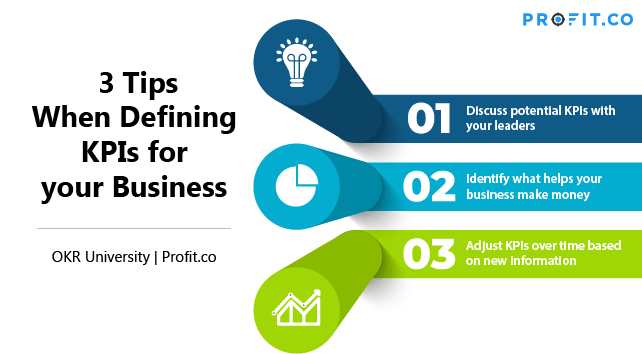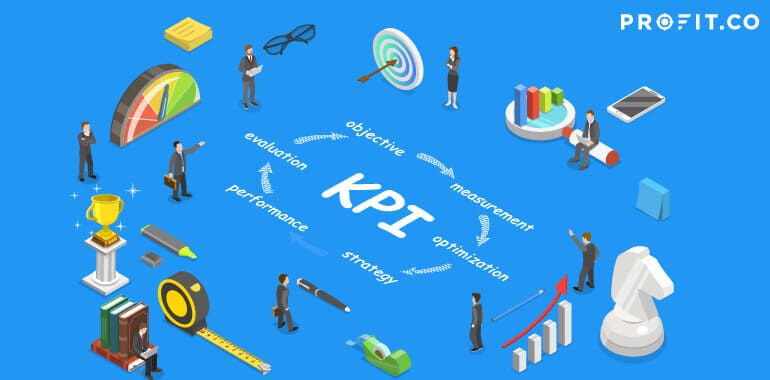You may hear people talk about key performance indicators, but you may not understand what they entail.
After all, the key indicators for each business can be different. You need to carefully select which indicators you would like to use your goals, and determine what the most important metrics are for your business to track.
Key performance indicators (KPIs) allow businesses to measure their successes. In this article, we’ll discuss the definition of KPI, why it matters, how you can develop your KPIs, and offer some examples.
What gets measured gets improved.
What Is KPI? Definition
Key performance indicators are simply the stats your business keeps track of. This can include the number of sales over a month, website visits, and anything else that helps you determine the health of your business.
Want to measure your important KPIs on an agile and intuitive OKR software?
KPIs can help you measure and track the progress of your goals. For example, if your business wants to gain more online visibility, it should make web visitors one of its KPIs. That way, you can focus on increasing the number of website visitors, which will create more visibility for your business online.
KPI metrics allow you to define the targets you need to reach in order to achieve your overarching goals. If you want to improve website traffic, you may want to measure organic traffic, click-through rates, and similar metrics that indicate a rise in web traffic.
The Importance of KPIs
Now that you understand what KPIs are, we want to talk about their importance. That way, you can define your own KPIs and begin measuring progress properly within your organization.
Give Your Business a Specific Goal
When you establish KPIs for your business to follow, you give your business some specific goals. Goals can help your business in multiple ways:
- Give yourself some direction on what to work towards.
- Understand what will improve your business.
- Ensure your employees understand what they need to work on.
Business goals can help everyone in the company focus on what your business needs. For example, if one of your KPIs is weekly sales, and you set an ambitious target to achieve within the quarter, your employees will know to prioritize making more sales and working together to try and reach this target as a team.
Measure Your Success
KPIs enable you to precisely measure the success of your qualitative goals. When KPIs have a baseline value, a target value, a deadline, and an owner, they become key results, which measure the progress of an objective.
If your team reaches your targets, you know that your business strategies and approaches to execution are sound. On the other hand, if you don’t reach your KPIs, you need to make some adjustments, so you can reach them in the future.
As you track your KPIs, you can see if they increase, decrease, or stay the same. Make sure you continually monitor them so you can see what initiatives are working for your goals, or what you need to adjust in order to see results.
Help Your Business Remain Focused
When you define KPIs for your business, everyone on your team knows what your business goals focus on. They know they must meet the targets set for each KPI, so they’ll remain focused on those numbers. This can assist your business with the following:
- Ensure your employees focus on the right work.
- Help them do what they must, so they can increase your business profits.
- Help them avoid activities that distract from reaching your KPI targets.
Working on KPIs helps your business focus on the most important priorities in order to increase its profits. If your employees know the KPIs they need to reach, they’ll do their best to focus on those KPIs.
How to Develop KPIs?

When defining your KPIs, keep these three tips in mind to help you develop the right KPIs for your team:
- Discuss potential KPIs with your leaders.
- Identify what helps your business make money.
- Adjust KPIs over time based on new information.
In order to define the right KPIs for your business, have frequent conversations with your managers, or other leaders in the company. Do not shy away from trial and error. If halfway through the quarter you realize the KPI you selected isn’t actually measuring your goal in the best way, you can be flexible and pivot.
However, it is important to do your best to select KPIs that indicate company priorities– for example, increasing profits.
As you identify these KPIs, you need to test them out. Keep the ones that work for your business, but don’t be afraid to test and develop them with time. You may find yourself discovering better KPIs, so transition to them as needed.
KPI Examples
Defining the right KPIs can be a difficult process. It helps to look at examples of KPIs to help you think of what your business truly needs to measure. There are many sources that you can go to get inspired. Take a look at these OKR examples to see how KPIs are used within the OKR framework, or even take to social media, where business influencers like Ram Bhupatiraju bring up good examples of KPIs. The following are Bhupatiraju’s example KPIs for e-commerce companies:
- Number of users.
- Growth and trajectory.
- Subscriptions and returning users.
KPIs like these help your business identify how the users interact with your business. However, you should find the KPIs that can help your business the most. For example, if you plan to focus on your blog, you should track information about your blog posts instead, such as the time spent on each article, the number of shares on a post, or the number of comments below the blog.
Frequently Asked Questions
1. What is KPI?
Key performance indicators (KPIs) are a set of specific, quantifiable, actionable measures that can be used to track and measure the progress of an organization or a team, or an individual toward their respective key objectives. They provide data-based insights about the performance of a business, teams and individuals.
2. What does KPI stand for?
KPI stands for Key Performance Indicator.
3. What is KPI in business?
KPI in business is metrics or a combination and comparison of metrics to measure if a company is achieving its key business objectives. They can be financial or non-financial. Some common KPIs used in business include revenue growth, profitability, customer satisfaction, employee retention, etc.
4. What are KPI metrics?
KPI metrics are the measures that provide statistical evidence for the progress you make towards your goals and objectives over a period of time.
5. What is a KPI report?
KPI report is a business report that captures the performance of individuals, teams, departments or the organization as a whole. It includes various data points and indicators, such as targets, actual values achieved, and percentages.
6. What is KPI reporting?
KPI reporting is the process of combining, consolidating and interpreting the data that is used to track and measure the performance of business organizations, and documenting actionable insights for disseminating with key stakeholders so as to plan for the future and take key business decisions.
7. What is KPI in marketing?
Marketing KPIs help you measure and track the performance of your marketing campaigns and their progress towards specific goals, such as increasing organic traffic. By tracking them, you can identify the aspects of marketing campaigns that are performing well and the ones that need improvement. With these insights, you can make necessary changes and adjustments to improve your overall results. Conversion rates, Cost Per Lead, Customer Lifetime Value, etc. are some of the marketing KPIs that you can track.
8. Which KPI is most likely to be a vanity metric?
Social media metrics such as likes, comments, number of followers, retweets, and number of video views seem significant, but have no perceivable impact on your business and do not indicate progress or performance. So, these superficial social media metrics are most likely vanity metrics.
9. What is a KPI example?
Current ratio, Debt to equity ratio, Net profit, Gross margin, etc., are some examples of KPIs.
10. How to measure KPIs?
You can measure KPIs by:
- Entering data in spreadsheets where you can compare and combine various data points to build insights, visualize them as charts and measure them.
- Use dedicated software, which automates the constant tracking and measuring of KPIs and uses AI to come up with comprehensive insights.
- Creating KPI dashboards using spreadsheets or aforementioned software to customize tracking a set of specific, relevant KPIs and derive insights.
- Using KPI tracking templates that are available online.
- Hiring consultants who can do it for you.
11. What is KPI in sales?
KPIs in sales are used to track and assess the performance of sales teams and executives. By providing sales-related insights, they enable data-driven decision making to improve sales strategy and close more deals. Some of the important sales KPIs include revenue, number of deals, conversion rate, average deal size, win rate, cycle time, etc.
12. What is a KPI dashboard?
KPI dashboards are tools that combine and consolidate data sources and provide comprehensive visual feedback and insights with respect to the performance of your business against your key performance indicators (KPIs).
13. What is KPI in project management?
Key Performance Indicators in project management measure how effectively the objectives of a project are met. KPIs used in project management include project completion rate, scope creep, budget overruns, etc.
14. What is KPI management?
KPI management is the process of setting up systems and processes to track and assess KPIs regularly for taking action towards improving performance wherever necessary. KPI management needs to be done by forging collaborations amongst various departments in an organization, and also between managers and employees. KPI management is part of a broader performance management system and should never be used in isolation.
15. What is a KPI in retail?
Retail KPIs help retail businesses track their business-critical performance parameters such as sales, customer satisfaction, employee productivity, operational efficiency, etc.
16. What is KPI in manufacturing?
Manufacturing KPIs help you measure the efficiency and performance of a manufacturing business. Some of the manufacturing KPIs include production output, product quality, production efficiency, manufacturing cost, production output, etc.
17. What is a good KPI?
A good KPI is SMART – Specific, Measurable, Achievable, Relevant and Time bound, and is linked to the objectives of the organization
18. What is the difference between KPI and OKR?
Key Performance Indicators (KPIs) are the means to measure the performance of various aspects of a business, individual or a team. Objectives and Key Results (OKRs) is a goal-setting framework that helps to set organization-level objectives and align employees at all levels to those overall objectives.
KPIs are set specifically for individuals, teams and the organization depending on what needs to be measured. OKRs are set by the top management and are cascaded from top to bottom so that the goals at individual levels can be always traced to the overall objectives.
KPIs are often fixed, while OKRs are constantly evaluated and changed whenever necessary.
19. What is the difference between KPI and metrics?
KPIs are usually linked to strategic goals, and can be a combination of metrics; they help measure the progress of individuals, organizations or business processes towards specific goals. Metrics, on the other hand, are simple, standalone data points or units of measurements that are not necessarily aligned to any strategic goal.
20. What is KPI vs KRI?
Key Performance Indicators (KPIs) help measure progress towards specific goals. Key Risk Indicators (KRIs) help identify potential risks and monitor them, so that any possible impact of those risks on the achievement of those goals can be averted or mitigated. KPIs are usually quantifiable parameters, while KRIs may not necessarily be quantifiable. Unlike KPIs that are more focused towards what happens within the organization, KRIs are often focused towards external factors. KPIs usually measure current performance, while KRIs take past performance into account to identify trends or patterns.
21. What is KPI and KRA?
Key Performance Indicators (KPIs) are quantitative parameters that measure progress of individuals, teams, departments and organizations towards their respective goals. Key Responsibility Areas (KRAs) are the qualitative factors or key areas of focus that require top level performance by employees to achieve an objective. They determine the roles, responsibilities and daily activities of an employee, giving him/her a sense of direction. In short, if employees effectively fulfill their responsibilities identified by means of KRA, they can efficiently achieve the desired results.
22. What is KPI in a job description?
KPIs mentioned in a job description state the expectations and deliverables from the particular role. They underline what the employee needs to deliver in order to be successful in the role. The KPIs mentioned in the job description are specific to the role and the nature of work that the position entails.
23. Why are KPIs so important?
KPIs help organizations keep track of performance in all key areas of focus and make sure that progress is made at individual, team and organization levels towards the organizational goals. They give the leaders of the organization relevant, business-critical insights, which help them make timely, data-driven decisions that can be detrimental to the success of the organization.
24. What are the three types of KPIs?
KPIs can be categorized into Strategic KPIs, Operational KPIs and Functional KPIs. Strategic KPIs are organization-wide KPIs that are set and tracked at the top level by the management, over a long period of time. Operational KPIs capture a short-term picture of the performance of various business processes. Functional KPIs are KPIs that measure performance parameters specific to a department and its functions.
25. How do you do KPI analysis?
You can do KPI analysis by
- Gathering all of the relevant data from various sources, such as reviews, surveys, financial reports, customer feedback, etc.
- Entering them in a spreadsheet or a KPI management software.
- Comparing and combining relevant metrics to measure KPIs.
- Visualizing the numbers through charts and graphs.
- Customizing relevant KPIs in the KPI dashboard for tracking regularly.
- Analyzing them and identifying any trends or patterns.
- Generating a report that outlines the findings and collates relevant data points, metrics, charts and supportive documents.
- Presenting the report to management for feedback and approval.
Final Comments
KPIs are a phenomenal tool to help you measure the effectiveness of your team and the progress of your goals. Take the time to think about what is important for your business goals, and what aspects of your business you need to focus on in order to best understand the health of your company.
Once you identify your KPIs, you can track them using Profit.co’s agile OKR management module! In order to learn how, or view our library of over 300+ KPIs in the product, schedule a demo with Profit.co’s experts today!

